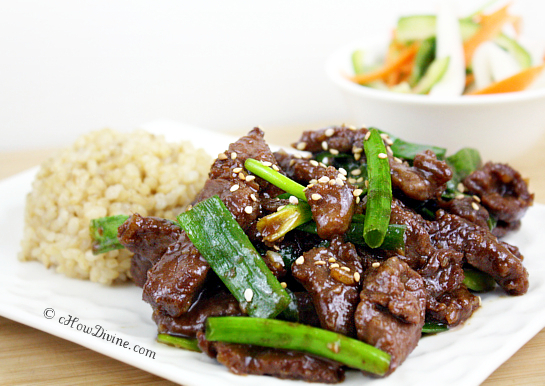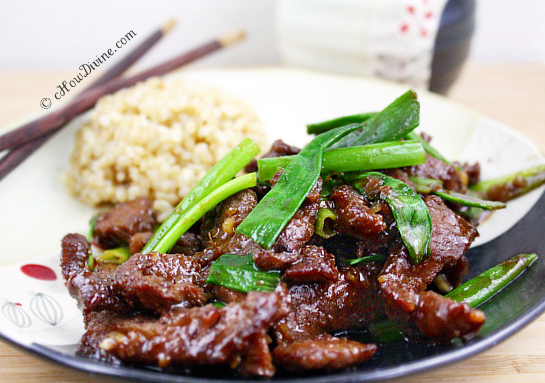When I was in elementary school, my uncle owned a popular Chinese restaurant in Los Angeles that catered to Americans. My family and I were there quite often and held most of our family celebrations at the restaurant. One of my favorite dishes was Mongolian Beef. It could have been THE favorite, considering I had the dish every time I was there. I even liked the green onions in the dish. And I generally hated green onions at the time.
I still like the taste of it. But the high sodium content prevents me from doing takeouts often (2700 mg of sodium per serving at 3 servings per plate, yikes!). Additionally, the beef is battered with starch and fried in many of the versions of the dish, even though the appearance might belie that fact.
So I make the dish at home. It’s become one of our favorites. And the at-home version takes less than 10 minutes of active cooking time. It will take less time than it would take you to get delivery or takeout. It is so easy to make. I still wouldn’t call it a traditional health food. But it’s A WHOLE LOT healthier than the takeout version. It’s lower in fat and sodium. And agave nectar is used instead of sugar. But it tastes like the real deal. It is soooooo delicious. Just thinking about it makes my mouth water.
Healthier Mongolian Beef Recipe
Makes 2 servings
Ingredients
1/2 lb beef tenderloin, thinly sliced against the grain
1 TB corn starch (optional)
2 cloves garlic, minced
1/4 tsp ginger, grated
2 1/2 – 3 TB tamari (gluten-free soy sauce)
1 1/2 TB agave nectar (or sugar)
1 tsp Chinese rice wine or dry sherry
2 TB water*
3 green onion, cut into 2-inch pieces (green parts only)
1-2 TB canola oil for the pan
- Stir together tamari, agave nectar, water, and Chinese rice wine/dry sherry. Set aside.
- Heat oil in a pan over medium-high heat. Make sure the oil completely coats the bottom of the pan. Dredge the beef in corn starch (if using). Shake off any excess starch. Add the beef and quickly sauté until lightly browned.
- Add garlic and ginger. Sauté for a few seconds. Add the sauce from step 1. The sauce should quickly come to a boil. Lower the heat a bit and allow it to bubble. Keep stirring. Reduce until it becomes thicker and glazes the beef. It should happen very quickly, within minutes.
- Throw in the green onions at the last minute. Mix. Turn off the heat immediately. Serve with steamed rice.
*Cook’s Note: The corn starch helps to brown the beef and thicken the sauce once the sauce is added to the pan. But I’ve made this plenty of times without it; the sauce thickens as it reduces, albeit not as thick. It tastes delicious regardless. And make sure to shake off excess corn starch. It’s not a batter, you just want to lightly coat or dust the beef. If you are not using starch, you do not need to add water to the sauce. Additionally, you can use low-sodium tamari (or half/half) to further reduce the sodium content.



Any other subsitute for the dry sherry/ chinese rice wine?? Don’t carry any of those and I don’t use any alcohol cooking (except vanilla extract :D)
I’ve used mirin, sake, and even soju when I didn’t have any Chinese cooking wine on hand. If you can find it, try and buy mirin. It’s very versatile and enhances the flavor of meat, poultry, fish, and vegetables. So it won’t be a one and done deal, and you can use it for other cooking purposes. If you can’t find ANY of the above, you can try using a BONE-DRY white wine. But that would be my choice of last resort. Vanilla extract, that would be interesting!!! 🙂
And any of those (including the dry sherry/rice wine) is ok for kids to have? I just want to make sure it is safe for them.
Also I didn’t mean to add vanilla extract to it I meant when you make homemade vanilla extract with vodka and vanilla beans is the only time I have alcohol on hand. 🙂
I totally knew you were joking! I enjoy food-related humor. 🙂 As far as the alcohol, it’s such a small amount and alcohol evaporates quickly when boiled in high heat. If you go to a restaurant, I’m pretty sure alcohol is added to many of the sauces (teriyaki for instance). But I understand your concern. I try not to use any alcohol when I cook for my nieces and nephews, because I don’t think 100% of the alcohol evaporates off. And if a recipe calls for a small amount of alcohol, I replace it with any homemade broth (veggie, chicken, beef, or anchovy-dashima) I have on hand when I know the kids will eat it. Additionally, if you are planning to double or increase the recipe, make sure not to overcrowd the pan. Do it in batches if necessary. You don’t want the beef to steam and turn gummy. You just want it to quickly brown.
Thanks so much for responding! In my household for christmas we usually have lumpias for christmas eve dinner (that’s when my niece and nephews come along with the rest of the family) and I love trying new asian styled recipes to go with it! It’s such a weird tradition since we are not of any asian descendants totally an all american household so when we tell people if they are coming over that we are having lumpias and fried rice and all these other sides they are like :\ because it’s such a normal thing to have ham and scalloped potatoes for christmas for a lot of people. We’re breaking the norm. 🙂
Once again thank you so much! Can’t wait to try this and many more dishes!
I love trying different types of cuisines too. Lumpias and fried rice sound great any time of the year. I would love to try your lumpia recipe! 🙂
Just made this tonight. I love the flavor! It was so quick and easy to make. I’ll be making this often. Thanks for sharing the recipe!
You’re welcome! We love this dish too. You really don’t need a bucketful of soy sauce to any dish flavorful. Thanks for sharing your results!!!
This look delicious and easy. Cannot wait to make your recipe. Thank you!
-Lynn
Thanks for coming by the site, Lynn! Hope you enjoy it!
and….you move up to the top of the *favorites* list!! 🙂 Cannot WAIT to make this! I haven’t been able to dine in Chinese restaurants for some time now…tummy troubles…think it’s the MSG, or high sodium content? This recipe will take care of both! Thanks SO much!
Thanks Bethany! You are so sweet! I have major problems with MSG and sodium as well. Hence, the low(er)-sodium recipes. 🙂 I really hope you enjoy it!
Hi! Cooking for a crowd and thought about this recipe. I also don’t cook with alcohol..so you would sub. for broth? Also, have you tried honey or pure maple syrup instead of agave?
Hi Jaisey ~ If you don’t want to cook with alcohol, you can add some beef broth or even water. The taste will be a little different, but not much. I wouldn’t sub with pure maple syrup. The flavors won’t quite mesh, IMO. But honey should be fine. Just pay mind to the viscosity of the honey. You don’t want to use some of the raw honey varieties that are too thick. And control the heat as needed since honey burns very quickly. Oh, almost forgot. If you are cooking a large quantity, cook in batches. It’s hard to control the heat of the pan, if you have too much meat on the pan at one time. It might result in “steamed” meat, instead of the nice sauté you’d want. I hope this helps!
Thanks so much!
I was thinking of adding water chestnuts to the mix. When would you recommend adding them to the beef?
Thanks.
Hi Amy! Water chestnuts are not traditionally used in Mongolian beef, but if I were to use it, I would put it in towards the end with about 3 minutes left of cooking. You can generally eat water chestnuts raw, and you would still want them crunchy. I hope this helps! Thanks for coming by the site! 🙂
I just tried this recipe today because I was in the mood for beef and we rarely have it at home. My kids praised me to no end about how amazing it was. I am so happy I decided to try this recipe and it is for sure going to be a regular dish in my home 🙂 thank you!!!
Thanks Jessica! I’m so happy you liked the recipe. It’s always so great to hear feedback. We just had it over the weekend too. It’s definitely one of our favorites. Thanks again for the comment and have a lovely rest of the week!